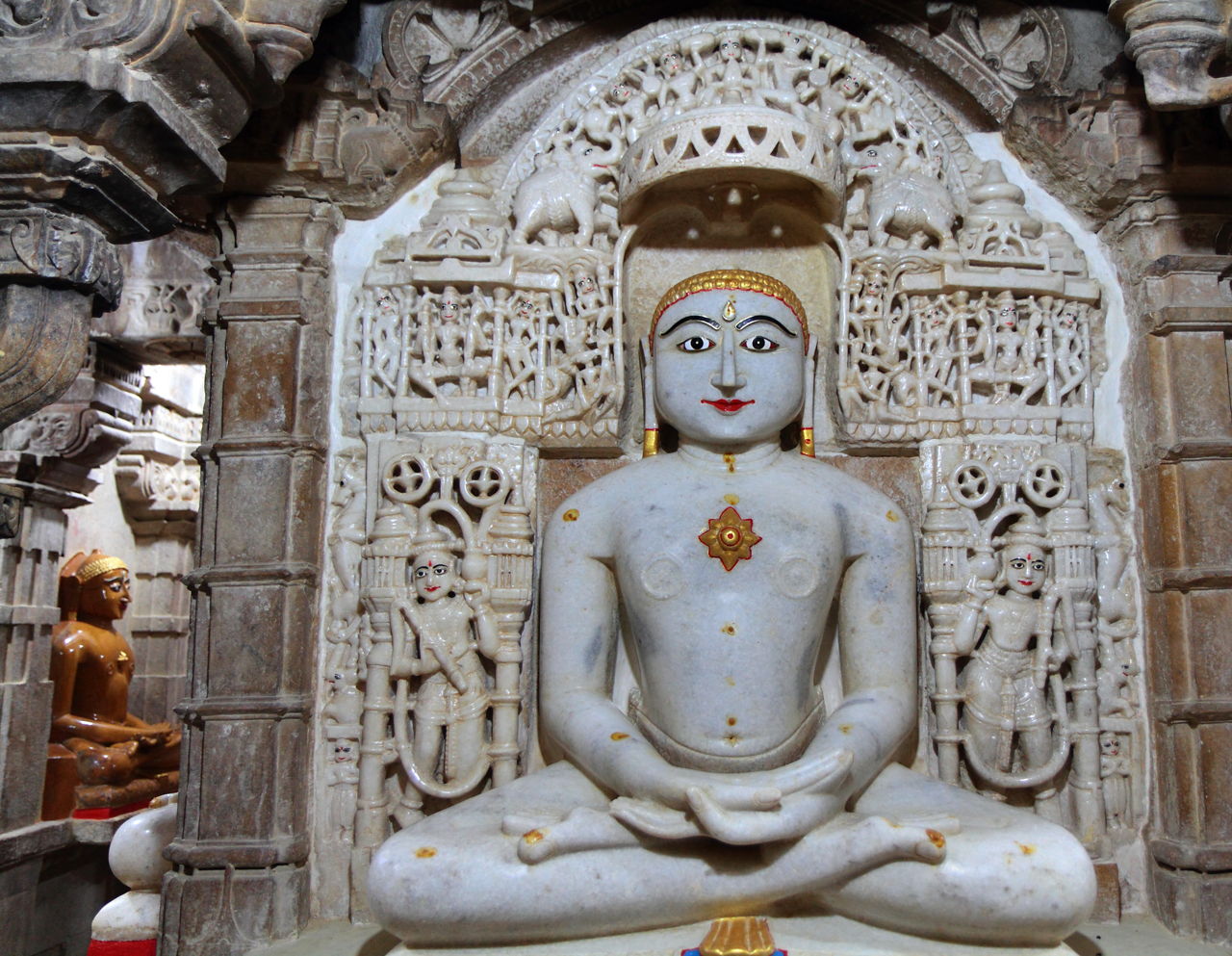
There are many different belief systems and religions followed by people across the globe. Christianity, Islam, Hinduism, Buddhism, Judaism and Sikhism are some of the major religions in the world. Jainism is one such religion of ancient India, known for its core principle of nonviolence. Here is an account of the fundamental concepts of Jainism, and the beliefs held by Jains.
“Conquer anger by forgiveness, pride by humility, deceit by straight-forwardness and greed by contentment.” ~ Lord Mahavira
A Jain is one who tries to follow the path of Jinas. A Jina is a person who has conquered worldly desires and reached the state of nirvana. Dharma is a ‘medium’ through which a jeeva (possessor of soul/any living being) wades through karmic particles of the sansar (world) towards moksha/nirvana. The concept of dharma is explained in many different ways.
Introduction to Jainism

What is Dharma?
Dharma: Vastu ka Mool Swabhav hi Dharma Hai. It means the inherent nature of an entity is its dharma. For example, water is cool in nature. However, upon absorbing heat, it loses its nature, temporarily. Water cools down when heating is stopped. Thus, it returns to its nature (coolness) when the acquired heat is shed.
Ahimsa Dharma
Nonviolence or Ahimsa is the inherent nature of a jeeva (soul). Ahimsa is the core principle which serves as the basis of all the teachings and theories of Jain Dharma.
- As per Ahimsa Dharma, it is not in the nature of a jeeva to cause harm. Even a seemingly violent creature like tiger doesn’t cause harm without a reason (hunger, threat, etc.). It is the Parinam(effects/result) of past karmas and the influx of newer ones which is responsible for the state in which a jeeva finds itself.
- All that is acquired by the soul (just like water absorbing heat from fire) dilutes its originality or purity; it makes the possessor of the soul, i.e. jeeva agitated or violent (just like boiling water). It is the inward journey – away from the ‘acquired’ (karmic particles) and towards the ‘inherent’ (gunas/qualities) – which brings stability, peace, and ultimately self-realization.
- Our soul is considered as a microcosm of the universe. Therefore, knowing ourselves means to know everything. This kind of knowledge is called Keval-Gyan (in Sanskrit it is Keval-Jnana and not Gyan). Keval-Gyan transcends all forms of knowledge, i.e. Mati-Gyan (empirical knowledge), Shrut-Gyan (articulate knowledge),Avadhi-Gyan (clairvoyant knowledge) and Manparyay-Gyan(knowledge of reading the mind). Keval-Gyan is considered pure and complete.
“A living body is not merely an integration of limbs and flesh but it is the abode of the soul which potentially has perfect perception (Anant-darshana), perfect knowledge (Anant-jnana), perfect power (Anant-virya), and perfect bliss (Anant-sukha).” ~ Lord Mahavira
Dharmastikay and Adharmastikay
In Jain Shastras (scriptures), the concept of dharma is described in many different ways. Dharmastikay (Medium of Motion), Adharmastikay (Medium of Rest), Jeevastikay (Soul), Ajeevastikay/Pudgalastikay (Non-living Matter), Aakashastikay (Space) and Kaal (Time) are the ‘Shat-Dravyas’ or six elements which intermingle to constitute the Sansar or Universe. Kaal is not an Astikay.
What is an Astikay?
This word is formed of Asti – space or body or mode, and Kay – the term which stands for collection. Thus, Astikay means collection of such spaces or bodies.
The medium of motion or dharma offers a jeeva with necessary medium to move. Adharma is the principle of rest. The following analogy should help in understanding this concept in a better manner: air provides the necessary medium for birds to fly. The branch of a tree offers them the place to rest. Interestingly none of them, either the dharma or adharma, influence the jeeva to either move or to rest. It is the choice of the jeeva which matters. Our universe is divided into Lokakash and Alokakash. The jeeva, ajeeva, dharma, adharma, kaal and aakash are the constituents of Lokakash. Alokakash is nothing but space.
Pudgala
The word Pudgala is formed of Pud (addition) and Gala (disintegration). It also means pudgala/matter undergoes transformation through addition and disintegration. A jeeva can experience the existence of pudgala by means of senses: tasting, smelling, touching, hearing, and seeing. This also means that the words that we hear and speak are a kind of pudgala.
Paramanu
A paramanu is the smallest division of pudgala. Multiple paramanus come together to form a skandha (molecule).
Utpad Vyay Dhrauvya
- Utpad: Origin
- Vyaya: Destruction/Spending/Loss
- Dhrauvya: Constancy/Firmness/Fixedness
As per the concept of ‘Utpad Vyaya Dhrauvya’, the pudgala (matter) undergoes Utpad and Vyaya continuously. Matter originates in one form and transforms into another. However, it maintains the inherent qualities (gunas) throughout the phases of transformation; this phenomenon is known as Dhrauvya. For example, water turns into vapor upon heating. However, it retains the inherent nature (of being water) throughout this transformation.
“My soul characterized by knowledge and faith is alone eternal. All other phases of my existence to which I am attached are external occurrences that are transitory.” ~ Lord Mahavira (Niyamasara, 99)
Dasha Dharma
The Dasha Dharmas (10 dharmas) followed by Jains are as follows. These dharmas allow practicing the Ahimsa dharma in a better manner.
- Kshama (Forgiveness)
- Mardav (Modesty/Humility)
- Aarjav (Straightforwardness)
- Shouch (Purity of Thoughts)
- Satya (Truth)
- Sanyam (Self-restraint)
- Tap (Penance)
- Tyaag (Renunciation)
- Akinchanya (Non-attachment)
- Brahmacharya (Supreme Celibacy)
“A person performing penance with a desire of fame or worship does not achieve a genuine penance; so penance should be observed without pomp and show, and one should not flaunt or praise it.” ~ Saman Suttam
Karmic Theory
The karmic particles (they are basically parmanus) attracted by a jeeva dilute the purity of the soul and create hurdles in the way towards Moksha. Aasrva (attracting the karmas), Bandh (bondage of karmas), Samvar (repelling the karmas), and Nirjara (shedding the past karmas) are the processes through which a jeeva continuously attracts and repels the karmas. Moksha is attained by that jeeva/soul who has shed all the past karmas and also repelled the newer ones. This is achieved with the help of Ratnatraya (Triple Gems) i.e. Samyak Darshan (Right Faith), Samyak Gyan (Right Knowledge) and Samyak Charitra (Right Conduct). It is believed that only a human being is capable of attaining Moksha. Therefore, it is necessary for a Dev (Heavenly Being), Narki (Hellish Being), or a Tiryancha (Animals, Birds, Insects, Plants, etc.) to take birth as Manushya (Human) before finally attaining Moksha.
“Those who are ignorant of the supreme purpose of life will never be able to attain nirvana (liberation) in spite of their observance of the vratas (vows) and niymas (rules) of religious conduct and practice of shila (celibacy) and tapas (penance).” ~ Lord Mahavira (Samayasara, 153)”
The Concept of Anadi Anant
Anadi Anant means without Aadi (Beginning) or Anta (End). Jainism was never established by a person. It was revived from time to time by Tirthankaras. The time cycle is divided into Utsarpini (Ascending Half) and Avasarpini (Descending Half). Each of these two halves are divided into 6 sub-sections. During the ascending half, the quality of life improves, while it undergoes degradation in the descending half. As per Jain scriptures, currently, we are in the 5th phase of the descending phase. The fourth phase ended shortly after the nirvana of Tirthankara Mahavira. The fifth phase, known as Dukhama (21,000 years) is followed by Dukhama-Dukhama (21,000 years). The six phases of Avasarpini (Descending Half) in sequence are as follows.
- Sukhama-Sukhama (Extreme Happiness)
- Sukhama (Happiness)
- Sukhama-Dukhama (Happiness with Little Sorrow)
- Dukhama-Sukhama (Sorrow with Little Happiness)
- Dukhama (Unhappiness)
- Dukhama-Dukhama (Extreme Unhappiness)
This order is reversed at the beginning of the Utsarpini, and so on. The total time span of the first 4 phases (of the descending phase) and last 4 phases (of the ascending phase) is too long to be measured with units of time available to us today.
The Sirsapahelika is a term used in reference with the highest measurable number i.e. 10^194.
Palyopama: This unit of time is also referred to as pit measured years. Here is how a palyopama can be calculated: fill an 8 x 8 x 8 miles pit with particles that are the size of the smallest portion of hair of a seven-day old. The particles should be taken out of the pit one at a time, every 100 years. The time taken to empty the entire pit is 1 palyopama.
Sagaropama: 10,000 trillion palyopama
1 Kalachakra (Time Cycle): 20,000 trillion sagaropama.
“Just as fire is not quenched by fuel and the ocean by thousands of rivers, similarly no living being is satisfied even with all the wealth of all the three worlds.” ~ Lord Mahavira (Bhagvati Aradhana, 1143)
Anekantavada and Syadvada
The word non-absolutism best describes the concept of anekantavada. It is one of the effective ways of understanding the truth. Here, you accept seemingly conflicting views as correct in their respective contexts. The concept of anekantavada can be understood in a better manner with the help of the story of the elephant and blind men.
A group of blind men were asked to visualize an elephant by touching it. The blind person who touched the legs of the elephant felt it was like a pillar. The one who touched its ears found it like a fan, while the other who touched its belly was reminded of a wall. One of them touched the trunk of the elephant and felt the creature resembled a branch of a tree. The blind person who got hold of the elephant’s tail thought it was like a rope. None of these blind men were wrong in describing the elephant in their own way. However, nobody had the correct understanding of how the elephant looked like. It means, people could be right in their way of thinking even if they apparently hold conflicting views. More importantly, truth can be understood by taking into account multiple viewpoints.
Syadvada
The word syadvada is formed of ‘syat’ (may be) and ‘vada’ (doctrine). Syadvada is a way of describing/studying a particular concept by taking into account the seven-fold predication – known as Sapta-bhangi Naya. Following are the perspectives or point of views being used to understand truth in a better manner.
- Syad-asti: “may be, it is” (from a perspective)
- Syad-nasti: “may be, it is not” (from a perspective)
- Syad-asti-nasti: “may be, it is and it is not” (from a perspective)
- Syad-asti-avaktavyah: “may be, it is and it cannot be described” (from a perspective)
- Syad-nasti-avaktavyah: “may be, it is not and it cannot be described” (from a perspective)
- Syad-asti-nasti-avaktavyah: “may be, it is, it is not and it cannot be described” (from a perspective)
- Syad-avaktavyah: “may be, it cannot be described” (from a perspective).
“The sadhaka (one who practices spiritual discipline) speaks words that are measured and beneficial to all living beings.” ~ Lord Mahavira (Kartikeyanupreksa, 334)
The Non-creator God
There is no creator-God in Jainism. As per Jain beliefs, the world was never created and it won’t get destroyed. A jeeva who attains nirvana is known as ‘Siddha’ or God. The place where Siddhas reside is known as Siddhashila – the abode of enlightened or emancipated; the Siddhashila, as described in Jain scriptures, resembles the shape of a crescent moon.
Namokar Mantra
Namo Arihantanam (Arihant)
Namo Siddhanam (Siddha)
Namo Aayriyanam (Acharya)
Namo Uwajhhayanam (Upadhyay)
Namo Loye Savva Sahunam (Savva Saadhu)
In the Namokar Mantra (Prakrit), the gunas (qualities) of the five entities (known as Panch Parmeshthi) namely Arihant, Siddha, Acharya, Upadhyay and Savva (all) Sadhu are worshiped. Thus, it is not about worshiping a particular person or people but qualities embodied by them. The word Namo stands for folding hands in reverence.
Arihant
The word Arihant is formed of ‘Ari’ (enemy) and ‘hanan’ (to destroy); Arihants are those who destroy their enemies – vices and desires. The Arihants resort to preaching out of compassion (for all the jeevas) before becoming Siddhas; which is why they are placed first in order in the Namokar Mantra.
Siddha
The one who has reached nirvana or beatitude.
Acharya
A Sadhu who leads a Sangha (group of Sadhus) and propagates the teachings of Arihants.
Upadhyay
Those Sadhus who study religious scriptures and propagate the knowledge contained in them.
Savva Sadhu
All (Savva) Sadhus who follow the path laid by Arihants and Siddhas under the guidance of Acharyas.
“Knowing that the earth with its crops of rice and barley, with its gold and cattle, and all this put together will not satisfy one single man, one should practice penance.” ~ Lord Mahavira (Uttaradhyayana, 9/49)
Jainism Beliefs and Traditions
Most of the traditions in Jainism revolve around the lives of 63 Shalaka Purush (63 great men). The lives of these great men inspires us to follow the path of courage, truth, and nonviolence.
63 Shalaka Purush
The 24 Tirthankaras, 12 Chakravarties, 9 Vasudevas (Narayans), 9 Prati-Vasudevas (Prati-Narayans), 9 Baladevas (Balabhadras) are the 63 Shalaka Purush or 63 men with great abilities mentioned in Jain scriptures. The list of Tirthankaras and the other 39 Shalaka Purush is given below. Symbols associated with each of the Tirthankaras are presented in this list. Apart from the Tirthankaras, the Chakravarties, Baldevas and Vasudevas are the ones being revered and worshiped. The Prati-Vasudevas are known to have traces of negativity in their characters.
24 Tirthankaras
The symbols associated with Tirthankaras are given alongside their names. These symbols are carved at the base of the idols of Tirthankaras.
Aadinatha (Ox)
Ajitnatha (Elephant)
Sambhavanatha (Horse)
Abhinandannatha (Monkey)
Sumatinatha (Curlew Bird)
Padmaprabhu (Lotus)
Suparshvanatha (Swastika)
Chandraprabhu (Moon)
Pushpadanta (Crocodile)
Shitalanatha (Kalpavriksha)
Shreyansanatha (Rhinoceros)
Vasupujya (Buffalo)
Vimalnatha (Boar)
Anantnatha (Porcupine)
Dharmanatha (Vajra)
Shantinatha (Deer)
Kunthunatha (Goat)
Arahnatha (Fish)
Mallinatha (Urn)
Munisuvrata (Tortoise)
Naminatha (Blue Lotus)
Neminatha (Conch Shell)
Parshvanatha (Serpent)
Mahavira (Lion)
12 Chakravarties
Shantinatha, Kunthunatha and Arahanatha were the Chakravarties who later on became tirthankaras. Therefore, the actual number of Shalaka Purush of this Avasarpini age is 60.
Bharat
Sagara
Meghavan
Sanatkumara
Shantinatha
Kunthunatha
Arahanatha
Subhauma
Padmaprabha
Harisena
Jayasena
Brahmadatt
9 Vasudevas (Narayanas)
Tripushta
Dvipushta
Svayambhu
Purushottama
Purushsinha
Pundarika
Dattadeva
Lakshmana
Shree Krishna
9 Prati-Vasudevas (Prati-Narayanas)
Asvagriva
Taraka
Naraka
Nishambhu
Madhukaitabh
Prahlada
Bali
Ravana
Jarasandha
9 Baldevas (Balbhadras)
Achala
Vijaya
Dharmaprabha
Suprabha
Sudarsana
Nandi (Ananda)
Nandimitra
Ramachandra (Padma)
Balbhadra (Balram)
Here is a list of some of the well-known Shalaka Purush of this Avasarpini.
- Chakravarti Bharat was the eldest son of Tirthankara Aadinatha.
- Shree Rama was the 8th Baldeva
- Lakshmana was the 8th Vasudeva
- Shree Krishna was the 9th Vasudeva
- Balram was the 9th Baldeva
- Ravana was the 8th Prati-Vasudeva
Samavasarana
It is a gathering where the Tirthankaras preach about the path leading to Moksha. The knowledge derived from such Samavasarana is condensed in Sutras (scriptures) and studied by Acharyas, Upadhyays, Sadhus, and Shravakas (any lay Jain/disciple). However, in the course of time, the need to document the Sutras arises due to the degeneration of intelligence and memorizing power of humans in general. Today, most of the documents/scriptures which trace back their origin to the Samavasarana of Tirthankara Mahavir are lost. One of the important scriptures derived from the Agamas (original Jain scriptures) is the Shatkhandagam. Tattvartha Sutra, Samaysara, and Acharanga Sutra are some of the important books in Jainism. The nature and geography of the constituents of the universe is described in detail in the Tattvartha Sutra. Samayasara provides an account of the nature of samay (Soul). The word, samay also stands for the smallest unit of time. According to Acharya Vidyanand, a celebrated digambar Jain monk, the Jain literature left with us today is just a drop in the ocean, if compared to the literature originally derived from the Samavasarana of Tirthankara Mahavira.
Jain Symbols and Colors
The Lokakash symbol, Right-Hand (palm) Symbol, Swastika and Kalasha are the important symbols in Jainism. The different colors associated with the Panch Parmeshthi – worshipped in the Namokar Mantra – are as follows.
Siddha: Red
Acharya: Yellow
Arihant: White
Upadhyay: Green
Sadhu: Dark Blue
Lokakash Symbol
This symbol represents the ‘Lok’ i.e. our universe. At the top of the Lokakash is the crescent shape (Siddhashila) with a dot (symbolizes the Siddhas) in the center. The three dots placed beneath the crescent shape stand for Ratnatraya (triple Jewels) while the Swastika depicts the four Gatis (destiny): Manushya (Humans), Dev (Heavenly Beings), Narki (Hellish Beings), and the Tiryancha (Animals, Birds, Insects, etc.). The right-hand (palm) stands for Ahimsa (nonviolence). The circle or wheel around the right hand depicts the Sansar (birth – death cycle), while the 24 spokes of this wheel represent the teachings of 24 Tirthankaras. At the bottom of the Lokakash symbol is a Sanskrit sutra, ‘Parasparopagraho Jivanam’. It means, life in this world requires mutual support between all the living beings. The Lokakash is divided into three sections:
- Urdhva-Lok: The abode of heavenly beings
- Madhya-Lok: The place where humans and Tiryancha reside.
- Adho-Lok: The place where hellish beings reside.
The Warriors Who Embraced Nonviolence
All the Tirthankaras and other Shalaka Purush mentioned above, were basically warriors. They were the princes, kings, emperors, and Chakravarties. So, one might wonder how the warriors (whom we generally associate with weapons and wars and violence) preach nonviolence. All these kings and princes had the courage and capability of conquering great empires. However, they also understood the futility of conquering the material world. In the end, it was the final frontier – the mind, full of vices or Kashayas (anger, greed, ego and deceit) – which they had to conquer before preaching nonviolence.
“It is better to win over self than to win over a million enemies.” ~ Lord Mahavira
Meaning of Nonviolence
Nonviolence means to abstain from violence. However, nonviolence is often misunderstood and associated with passivity or inaction. It would be a mistake to equate passivity with nonviolent actions. Nonviolence, in the true sense, is defending ourselves from external forces of violence, as well as keeping a tab on our vices (the root cause of violence), so as to refrain from violence.
Anyone with an insight on the execution on military operations would know about the clinical approach undertaken by defense forces in accomplishing their missions; soldiers are trained to eliminate the enemy (violent actions of the enemy) with no or minimum casualties. They fight to preserve nonviolence. Their aim is not necessarily eliminating the opponents, but the threat posed by them. Actions of soldiers are driven, not by the urge to kill, but the need to protect! Soldiers are the messengers of peace, the greatest ambassadors of nonviolence. May be, that is the reason why we call them defense forces and not ‘offense’ forces.
“Just as you do not like misery, in the same way others also do not like it. Knowing this, you should do unto them what you want them to do unto you.” ~ Lord Mahavira (Bhagavati Aradhana, 780)”
Fast Facts on Jainism
Jain Food Habits
- The food habits of Jains are governed by the principle of nonviolence. Jains follow a vegetarian diet in order to cause minimum harm to life on earth.
- Some Jains avoid eating root-vegetables and tubers, so as to avoid killing smaller organisms which grow in the soil.
- In India, ‘upvas’ is the term used for fasting. Upvas means to get near/close to God (our ‘self’). Fasting helps in meditating in a better manner. Also, fasting has many health benefits to offer.
Bahubali (Gomateshwara)
- Lord Bahubali was the son of Tirthankara Aadinatha, and younger brother of Chakravarti Bharat. The reason behind Bahubali being highly revered by Jains is that he was the first to attain Moksha or liberation in this Avasarpini age.
- Bahubali was named so because of his strong physique. As per ‘Adipurana’, the state of Takshashila/Taxila (in today’s Punjab, Pakistan) was ruled by Bahubali. The elder brother Bharat succeeded his father, Tirthankara Aadinatha, and ruled the state of Ayodhya (in today’s Uttar Pradesh, India).
Hanumana and Ravana
- As per Jain literature (Padmapurana), Ravana was a human. Similarly, Hanumana and Sugriva were humans. In fact, Hanumana, just like Shree Rama, attained Moksha and became a Siddha.
- Hanumana and Ravana belonged to the ‘Vidyadhar’ Vansha (clan). The Vidyadhar was one of the four main clans of humans. The four clans were the Ikshvaku Vansha (Surya Vansha), Rishi Vansha (or Chandra Vansha), Vidyadhara Vansha, and Hari Vansha.
Digambar Jain Monks
- Digamber Jain monks are also known as sky-clad, because they go to the extent of renouncing their clothes in the quest to give up worldly possessions.
- Digambar monks take ‘aahar’ (food and water) once a day. Their only possessions are a Pinchhi (made from peacock feathers, naturally shed by the birds) for sweeping the ‘asana’ (the place where they sit), to avoid killing small creatures, and a Kamandalu (an oblong water container) to maintain personal hygiene.
Teachings of Tirthankara Aadinatha
- Aadinatha/Rishabhnatha taught his subjects how to practice Asi(Warfare), Masi (Art of Writing), Krishi (Agriculture), Vidya (Knowledge Transfer), Vanijya (Commerce) and Shilp (Art).
- Aadinatha taught his subjects how to till the land and practice agriculture with the assistance of the ox (symbolizes strength and hard work). He also taught his daughters Brahmi and Sundari how to write alphabets and numerals respectively.
Arhat Dharma and Shraman Dharma
- In ancient India, Jainism was known by the name Arhat Dharma. The Arhat Dharma was practiced by followers of Arihants.
- Jain monks are known as Shramans; therefore, Jainism was also known as Shraman Dharma.
Ajnabhvarsha and Bharatvarsha
- Ancient India was known as Ajnabhvarsha, named after Nabhiraj, father of Tirthankara Aadinath.
- When Chakravarti Bharat, the eldest son of Tirthankara Aadinatha, started to rule Ajanabhvarsha, it was renamed Bharatvarsha.
There is a lot to study about Jainism. The rational approach taken by Jain Sadhus in deciphering the nature of the soul is the specialty of Jainism. A write-up like this can only present an overview of the fundamental concepts of Jainism.


